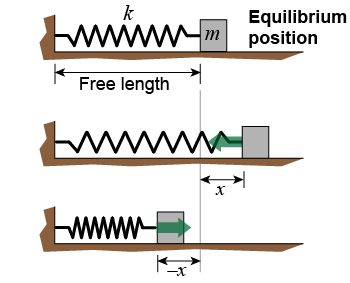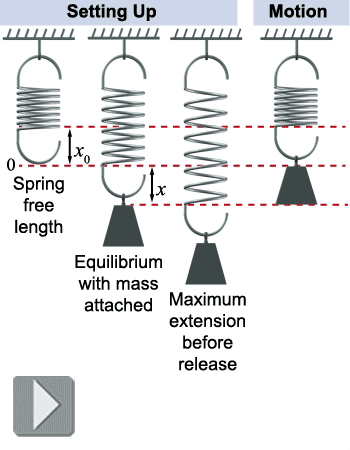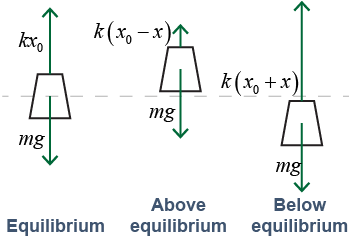|
 Consider a mass on a frictionless surface. The mass is connected to a spring that is fixed at one end. If the mass is displaced we have a situation similar to that of the pendulum. The spring supplies a restoring force that always pushes (or pulls) the mass back toward its equilibrium point. Understanding these systems is important because many real physical systems behave like spring–mass oscillators, including musical instruments, geological formations in an earthquake, and even atoms in a solid.
Consider a mass on a frictionless surface. The mass is connected to a spring that is fixed at one end. If the mass is displaced we have a situation similar to that of the pendulum. The spring supplies a restoring force that always pushes (or pulls) the mass back toward its equilibrium point. Understanding these systems is important because many real physical systems behave like spring–mass oscillators, including musical instruments, geological formations in an earthquake, and even atoms in a solid. 
|
When we observe a mass and spring oscillator in the lab we find the following: - The frequency increases when the spring gets stiffer (that is, has a higher k).
- The frequency decreases when the mass increases.
- Like the pendulum, the frequency is virtually independent of amplitude.

|
A way to create a nearly frictionless mass and spring oscillator is to hang the spring vertically. The spring stretches until at equilibrium the upward force from the spring is equal to the weight of the hanging mass. This “pre-stretched” state is the equilibrium position for the vertical system. 
| 
|
If the mass is pulled down below this “pre-stretched” equilibrium position and released, the system oscillates up and down. The amplitude of the oscillation is measured relative to the equilibrium position. The oscillation exchanges elastic potential energy stored in the spring with kinetic energy of the moving mass. 
|
 Although there are also changes in height, gravitational potential energy does not contribute to the oscillation! You can see this by looking at the free-body diagram of the hanging mass. The force of gravity (weight) stays constant and does not change direction, no matter what position the mass is in. Gravity does not create the restoring force, and therefore gravitational potential energy is a “spectator” and does not contribute to the oscillation.
Although there are also changes in height, gravitational potential energy does not contribute to the oscillation! You can see this by looking at the free-body diagram of the hanging mass. The force of gravity (weight) stays constant and does not change direction, no matter what position the mass is in. Gravity does not create the restoring force, and therefore gravitational potential energy is a “spectator” and does not contribute to the oscillation. 
|
What is the net force acting on the mass when it is above equilibrium? Use the free-body diagram above for reference. - −kx
- −mg
- k(x0 − x)
- kx − mg
 |
The answer is a. At any point the weight, −mg, cancels with the equilibrium force, kx0, from the spring. 
|

